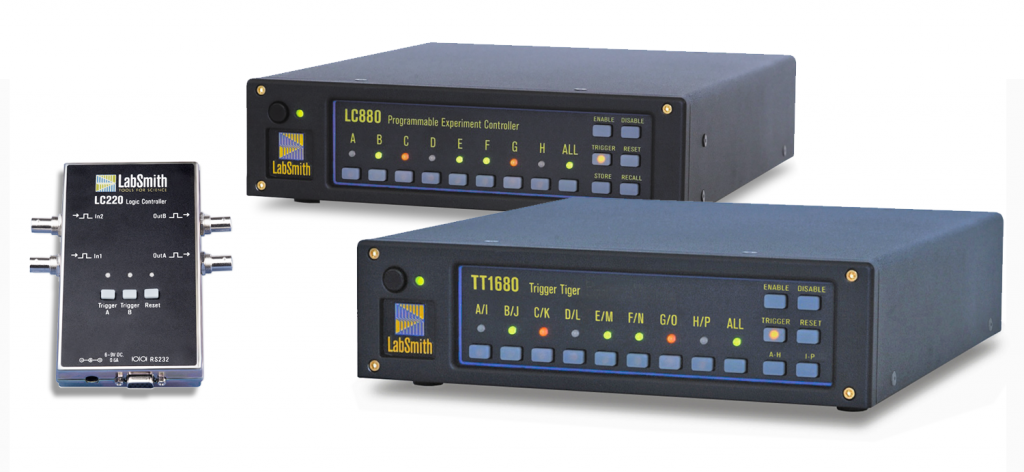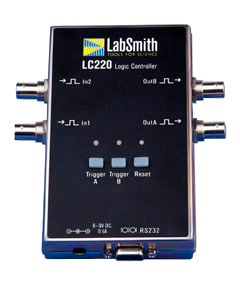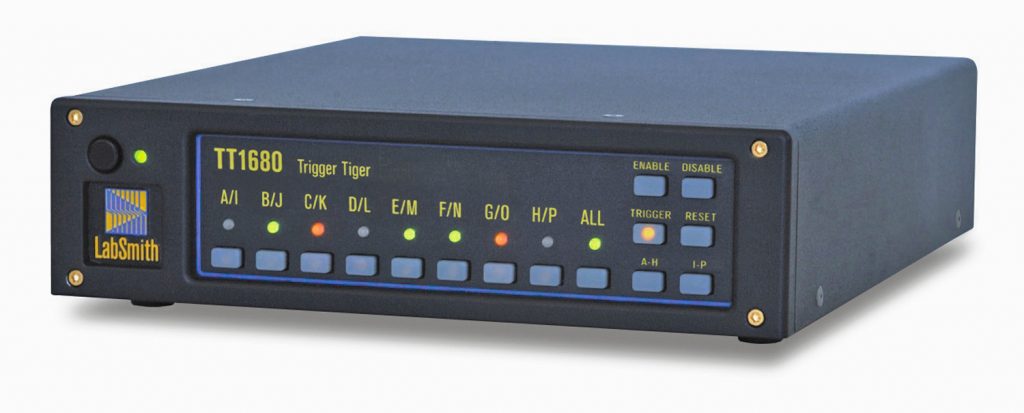LabSmith’s timing controller family:
Tame your timing challenges
Precise event timing, such as pulsing a laser or triggering a camera, is a job often “solved” with complex equipment and a tangle of cables. Uncoordinated systems can take hours to set up, with glitchy results. The more complex the setup, the larger the racks full of equipment—and the greater the aggravation.
One LabSmith experiment controller can outperform a rack full of delays, gates, timers, filters and cables — all for the price of a single delay generator.
No other instrument gives you so much power, to coordinate, integrate and synchronize complicated physical experiments, simply, reliably and affordably.
Multiple functions per channel
With a single LabSmith controller you can synchronize cameras, lasers, shutters, choppers, solenoids, igniters, etc., all
with 10ns resolution and 100ps accuracy.
Each channel can serve as adigital delay generator, logic gate, timer, clock, counter, delayed trigger or delayed pulse.
You also get functions that are simply not available elsewhere. such as Dynamic delay triggering to capture elusive phenomena or control uncertain timing situations, and False-trigger suppression to control noisy signals and prevent unwanted triggering.
Visit the LC220 2-channel experimental timing controller page
Far more than a digital delay generator
LabSmith controllers surpass the functionality of digital delay generators by leaps and bounds, integrating a programmable-logic front end, an array of intelligent timing processors, external inputs and outputs, and < 11 ns throughput time.
Each channel can operate in many different modes:
Delayed-Pulse Mode: a pulse of specified duration (8 µs to 1370 s) after a specified delay (50 ns to 1370 s).
Dynamically Delayed Pulse Mode*: the processor measures the delay between successive inputs, calculates an output pulse delay, then supplies an output pulse after the calculated delay, with < 20 ns uncertainty.
Toggled Output Mode: the channel toggles output with each trigger signal.
Noise-Suppression Mode*: the processor supplies an output pulse only after its input has remained high for a definable duration. This unique timing mode guards against false triggers by noise glitches.
Fixed Mode: output is either high or low, regardless of input.
Passive Mode: output is equal to its input, or the inverse of its input.
Clock Mode: a repetitive pulse train with specified high- and low-state durations up to a frequency of 780 kHz.
Timer Mode: the processor measures, reports and stores the delay between successive inputs, with < 20 ns uncertainty.
*Unique to the LC880
Software-programmable feedback between channels lets you implement sophisticated controls, simply.
Visit the LC880 8-channel experimental timing controller page
Multi-channel coordination
While there’s plenty of value in a box full of precise timing channels, there’s even greater benefit in integrating channels to handle complex timing challenges.
Each channel’s response can be based on input logic, outputs from other channels, or feedback from real-world monitoring. You can employ safety interlocks and switches to toggle between operating modes (free-run, single-shot, calibration), all without jumper cables or external logic. Each channel can even change modes based on logic or real-world input.
Visit the TT1680 16-channel experimental timing controller page
Eliminate the cable tangle
External cabling and hard-wired logic simply can’t match a logic processor’s speed. The digital timing processors in LabSmith controllers enables 11 ns throughput, and absolute timing reliability:
Easy to learn scripting
LabSmith controllers are based on the simple Trigger scripting environment, employing sophisticated logic, gating and filtering. Choose to work in a Windows or LabVIEW environment, depending on your preference.
Use the hardware controller as part of a computer-based control system using Trigger or LabView. Or, program the unit through the software, then untether it to operate in stand-alone mode, storing and recalling up to 64 complete settings, so you can trigger and monitor an experiment from the front panel.
Field-updatable software and firmware helps future-proof your system—an especially important benefit for ongoing research.
Incredible value, for simple or complex setups
LabSmith timing controllers are available with the right number of channels to serve your application:
2-channel LC220 is designed for embedded applications and projects requiring just one or two precision timing channels
8-channel LC880 for experimental setups requiring more coordinated timing
16-channel TT1680 to handle the most challenging timing applications
In applications from gas dynamics to fracture mechanics, LabSmith experiment controllers have earned their place among oscilloscopes and power supplies as indispensable tools for the lab.




